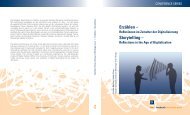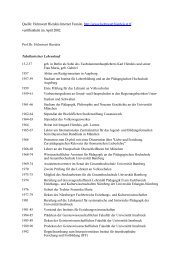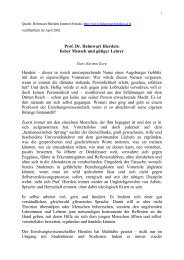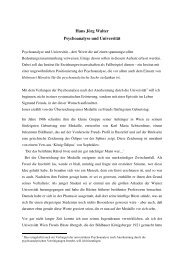Download pdf - Universität Innsbruck
Download pdf - Universität Innsbruck
Download pdf - Universität Innsbruck
Erfolgreiche ePaper selbst erstellen
Machen Sie aus Ihren PDF Publikationen ein blätterbares Flipbook mit unserer einzigartigen Google optimierten e-Paper Software.
Sharing as Educational Practice: A Case-Study from University of Udine 73<br />
side the classroom? Can the popularity of social media be an advantage for the education<br />
process and can SNS positively influence learning practices? In recent years, several<br />
studies were able to partially answer these research questions, showing that these online<br />
environments can support educational activities and learning experiences by allowing interaction,<br />
collaboration, communication, participation and resource sharing among the<br />
users (Selwyn, 2009). As highlighted by Mazman & Usluel,<br />
“Using social networks in educational and instructional contexts can be considered<br />
as a potentially powerful idea simply because students spend a lot of<br />
time on these online networking activities. While the current generation of<br />
Learning Management Systems (LMS) allows each student to have their personally<br />
chosen course(s) in which they are enrolled, many of these LMS lack<br />
of social connectivity tools and personal profile spaces that can be used by<br />
the students involved.” (2010, p. 444)<br />
The analysis produced by Mazman & Usluel is currently shared by many other scholars.<br />
Also, Dunlap & Lowoenthal (2009) and Schroeder & Greenbowe (2009) for example argue<br />
that, although LMS offer several useful tools that support student engagement, their<br />
structures can inhibit social interaction. However, it is becoming evident that the increasing<br />
adoption of Internet-based platforms by the young generation can help in overcoming<br />
the limits cited above and their experience in social media can be exploited to facilitate the<br />
social process of learning. According to Ras & Rech:<br />
“The Net Generation students put new requirements upon software engineering<br />
education because they are digitally literate, always connected to the<br />
Internet and their social networks. They react fast and multitask, prefer an<br />
experimental working approach, are communicative, and need personalized<br />
learning and working environments.” (2009, p. 555)<br />
Ras’s and Rech’s ideas are shared by many other authors who suggest that current social<br />
media can be seen as the right space for collaboration, communication and interaction<br />
between students, tutors and professors. In their perspective, SNS provide online environments<br />
and collaborative features for students to engage in social activities, lead online discussions,<br />
present their ideas and share their points of view. They can facilitate student-tostudent<br />
collaboration, help professors to share educational content, provide innovative<br />
ways to involve young people in some topics and enhance communication among teachers<br />
and students and among students themselves. Above all, SNS are characterized by gratuitousness,<br />
ease of use, allowing for rapid updating, network effects and ready availability<br />
(Boon & Sinclair, 2009). Integrating SNS into existing educational practices becomes significantly<br />
important to achieve more robust learning opportunities (Mazman & Usluel,<br />
2010), but, obviously, the professor monitoring (that is, reviewing, discussing, etc.) continues<br />
to play a pivotal role also during collaborative learning (Dillenbourg, 1999). According<br />
to Mazman & Usluel SNS provide
















